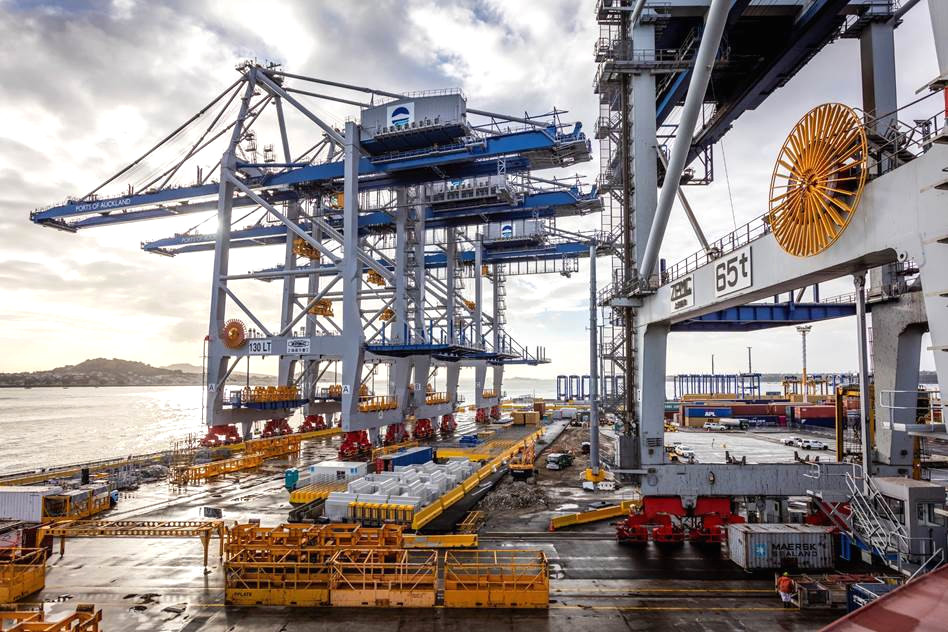
The three cranes the Ports of Auckland paid $60 million for that were built by Chinese multinational engineering company ZPMC.
The Ports of Auckland says three cranes it paid $60 million for haven’t been used for any actual work since they were delivered from Shanghai in October last year.
Chinese multinational engineering company ZPMC built them and the Ports of Auckland originally said it hoped to have them up and running within five to six months.
Spokesman Matt Ball says while there have been some minor issues with the cranes, despite rumours to the contrary, there is nothing wrong with them.
“We found some malware on the cranes back in January, but that was eradicated a while back,” Ball says.
Peak exports
He says the main reason for the delay in getting the cranes up and running is largely due to the timing of when they arrived and when they could be tested.
“At the time the cranes were delivered we thought we might work a few trial ships with them around the middle of the year, but we decided not to, for two reasons. We changed the timing of automation so that going live didn’t happen during the export peak, and because of the amount of infrastructure work going on for automation, like pavement work in the area behind the cranes.”
Ball says the Ports of Auckland is still trialling them.
“We are currently using them in automation testing and they’ll be coming into operational service when we go live with automation in February 2020, as planned. So yes we’ve had some challenges during commissioning, but nothing more than you’d expect in a project of this size and complexity.”
Future proofing the port
Standing 82.3 metres high and weighing 2,100 tonnes each, the cranes can lift four 130 tonne containers at once.
In a statement from the Ports of Auckland in September last year, just before the cranes first arrived by ship from Shanghai, Ball said they were needed to meet the growing levels of freight the port was handling.
“We need bigger, faster cranes so we can keep up with Auckland’s growth. More people in the city means more freight. The ships that bring our goods from overseas are getting bigger, so we need to make sure we can handle them. With these new cranes, and the new deep water berth they will sit on, we’ll be able to handle the biggest ships coming to New Zealand.”
Capital costs
The Ports of Auckland has increased its debt by 30% since last year as part of an investment programme to increase its capacity and returns, despite the fact its long-term future hangs in the balance.
A report released earlier this month shows the Auckland Council’s dividends from the port will be slashed in 2020 and 2021. The Ports of Auckland Statement of Corporate Intent (SCI) covers the period from July 1, 2019 to June 30, 2022. It shows the council will receive projected dividends of just $8.7 million in 2020 and $9.4 million in 2021 before increasing again to $64.3 million in 2022. Auckland Council currently has 100% ownership of the port and it received an annual dividend from its shareholding of $51.1 million in the 2017/18 financial year.
The lower dividends are because the port is in a ‘capital expansion’ period and the projected returns are now expected to dip slightly in 2019/2020 before recovering in 2020/2021.
The Ports of Auckland says the expansion work is designed to improve the port’s capacity, automate some of its operations and reduce the impact of car imports on Bledisloe and Captain Cook wharves. This investment, which also includes the construction of a new Waikato Freight Hub, has resulted in an increase in the ports debt from $368 million to $479.7 million.
In 2016 the Auckland Council formed a working group to look at the long term options for the Ports of Auckland. The resulting Port Future Study said that the port would face problems going forward due to its location. The report identified two potential locations for a new port at either the Manukau Harbour, or the Firth of Thames, which it said should be investigated.
